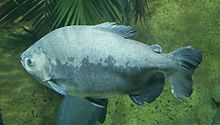Colossoma macropomum
| Tambaqui Temporal range: Miocene - recent |
|
|---|---|
 |
|
|
Not evaluated (IUCN 3.1)
|
|
| Scientific classification | |
| Kingdom: | Animalia |
| Phylum: | Chordata |
| Class: | Actinopterygii |
| Order: | Characiformes |
| Family: | Serrasalmidae |
| Genus: |
Colossoma C. H. Eigenmann & C. H. Kennedy, 1903 |
| Species: | C. macropomum |
| Binomial name | |
|
Colossoma macropomum (G. Cuvier, 1818) |
|
| Synonyms | |
|
|
The tambaqui (Colossoma macropomum) is a large species of freshwater fish in the Serrasalmidae family. It is native to tropical South America, but kept in aquaculture and introduced elsewhere. It is also known by the names black pacu, black-finned pacu, giant pacu, cachama, gamitana, and sometimes as pacu (a name used for several other related species).
The tambaqui is currently the only member of Colossoma, but the two Piaractus species were also included in this genus in the past.
The tambaqui is native to freshwater habitats in the Amazon and Orinoco basins of tropical South America. In nutrient-rich whitewater rivers such as the Madeira, Juruá, Putumayo (Içá) and Purus it ranges throughout, all the way up to their headwaters. In nutrient-poor blackwater rivers such as the Rio Negro and clearwater rivers such as several rightbank tributaries of the Madeira it generally only occurs in the lower c. 300 km (190 mi) and is rare beyond the lowermost c. 150 km (95 mi). It is widely kept in aquaculture outside its native range in South America.
The tambaqui is the heaviest characin in the Americas (the lighter Salminus can grow longer) and the second heaviest scaled freshwater fish in South America (after the arapaima). It can reach up to 1.08 m (3.5 ft) in total length and 40 kg (88 lb) in weight, but a more typical size is 0.7 m (2.3 ft). The largest caught by rod-and-reel and recognized by IGFA weighed 32.4 kg (71 lb). After the flood season, around 10% of a tambaqui's weight is the visceral fat reserves and at least another 5% is fat found in the head and muscles.
...
Wikipedia
